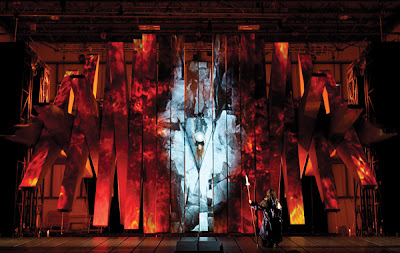 |
| Johannes Brahms, looking less than jolly. Drawing by Andrey Volkov |
OK. Before you all start writing me letters about how all five box sets in this article are Deutsche Grammophon reissues, I want you to know that I'm aware of that. It just happens that these are five of the best CD box sets released in 2010. It's a coincidence that they're all on the same label.
Really. I swear on my little brass bust of Beethoven.
Anyway, here's the list:
Boulez Conducts Stravinsky
This set collects the Stravinsky recordings made by Pierre Boulez at the start of his fertile second summer as a recording conductor. They feature three great orchestras (Chicago, Cleveland and the Berlin Staatskapelle) and clarity of texture These performances were made in the 1990s, with great international orchestras: the Cleveland Orchestra, Chicago Symphony Orchestra and the Berlin Staatskapelle.
These recordings range from the major Stravinsky ballet scores to dramatic poems and the lesser-known works from his neo-classical period. Everything here is played with exceptional clarity of texture, driven, yet not rushed tempos, and a keen understanding of Stravinsky's fearless experimentation from a composer known for his own avant-garde ideas.
Emerson String Quartet: The Complete Beethoven String Quartets.
This set leapt to the very top of the heap of Beethoven string quartet recordings when it was released in the late '90s. Here, it returns to the catalogue as part of DG's 'Collector's Edition' series, which helps music lovers save considerable amounts of shelf space.
The Emersons offer driving, muscular interpretations of the sixteen Beethoven quartets in glittering digital sound. Highlights of the cycle include a lyric trio of 'Razumovsky' Quartets, and a beautiful run-through of the famous 'Harp' Quartet.
The best part of the set is the Emersons' fearless exploration of the difficult final quartets. They offer both the 'Grosse Fugue' (originally written as the finale for Quartet No. 15) and the tamer 'alternate' movement, played with the same sence of precision and skill. By the time the last quartet is reached, the listener may finally understand why Beethoven scrawled "Muss es sein?...Es muss sein!" on the manuscript. If you figure it out, write in and tell us. We love mail.
Martha Argerich: The Collection 3: Chamber Music
This is the third installment in a series of box sets reissuing Martha Argerich's DG recordings. The first two focused on her solo recitals
For those of you not familiar with Ms. Argerich's work, she is a brilliant, refreshing pianist whose fearless technique shot her to the top of the classical music world by the age of 21. In her maturity, she moved away from solo recitals, preferring to perform with other pianists or in small groups.
Here, the label says "chamber music" but a better title might be "Chamber works and music for two pianos." Of the six discs, the highlight is definitely a series of two-piano arrangements of works by Ravel, Prokofiev and Tchaikovsky. Most of these are performed in collaboration with Russian pianist Mikhail Pletnev, and they offer an interesting angle on Ms. Argerich's piano skills. That they're gorgeous performances which kick major ass is also part of their appeal.
Vladimir Horowitz: The Complete Recordings on Deutsche Grammophon
Vladimir Horowitz is one of the most important pianists of the 20th century, a master of the instrument who specialized in Chopin and the knotty, cerebral music of Alexander Scriabin. These recordings were made in a fertile period of two years at the end of the great pianists' life, and preserves his final recital in Hamburg, as well as works by Schubert, Schumann and Mozart.
The major performance here is the Moscow Concert, which is also available separately
This set was originally issued on just four discs, but this new version consists of seven seperate discs, each packaged in a replica of the original LP sleeve. (The content, however, is the same.) On the bright side, the label didn't jack the price of the music, which is priceless no matter how it's packaged.
Hugo Wolf: Lieder
If you're not conversant with German art-songs, the name Hugo Wolf may be entirely new to you. Wolf's music follows in the expression of Romantic ideals set forth by Wagner and Liszt, but with the musical ideas compressed into tight, powerful songs that say in five minutes what it takes Wagner six hours to express.
This brilliant collection is a welcome reissue from the vault, featuring the consumnate, intelligent interpretations by baritone Dietrich Fischer-Dieskau. The young Daniel Barenboim is an ideal accompanist--and would go on to become a great Wagner conductor in his own right.
Wolf's music isn't exactly Christmas-time listening. His songs are settings of dark, Romantic poetry, and the harmonic brilliance and chromaticism can take getting used to. But this is an essential set, folks, with the finest baritone for this music: a dramatic, intelligent singer who finds the soul in each one of these five-minute gems.
























